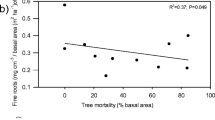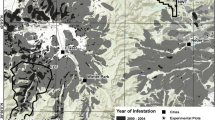Abstract
Outbreaks of Dendroctonus beetles are causing extensive mortality in conifer forests throughout North America. However, nitrogen (N) cycling impacts among forest types are not well known. We quantified beetle-induced changes in forest structure, soil temperature, and N cycling in Douglas-fir (Pseudotsuga menziesii) forests of Greater Yellowstone (WY, USA), and compared them to published lodgepole pine (Pinus contorta var. latifolia) data. Five undisturbed stands were compared to five beetle-killed stands (4–5 years post-outbreak). We hypothesized greater N cycling responses in Douglas-fir due to higher overall N stocks. Undisturbed Douglas-fir stands had greater litter N pools, soil N, and net N mineralization than lodgepole pine. Several responses to disturbance were similar between forest types, including a pulse of N-enriched litter, doubling of soil N availability, 30–50 % increase in understory cover, and 20 % increase in foliar N concentration of unattacked trees. However, the response of some ecosystem properties notably varied by host forest type. Soil temperature was unaffected in Douglas-fir, but lowered in lodgepole pine. Fresh foliar %N was uncorrelated with net N mineralization in Douglas-fir, but positively correlated in lodgepole pine. Though soil ammonium and nitrate, net N mineralization, and net nitrification all doubled, they remained low in both forest types (<6 μg N g soil−1 NH4 +or NO3 −; <25 μg N g soil−1 year−1 net N mineralization; <8 μg N g soil−1 year−1 net nitrification). Results suggest that beetle disturbance affected litter and soil N cycling similarly in each forest type, despite substantial differences in pre-disturbance biogeochemistry. In contrast, soil temperature and soil N–foliar N linkages differed between host forest types. This result suggests that disturbance type may be a better predictor of litter and soil N responses than forest type due to similar disturbance mechanisms and disturbance legacies across both host–beetle systems.




Similar content being viewed by others
References
Berg B, Steffen KT, McClaugherty C (2007) Litter decomposition rate is dependent on litter Mn concentrations. Biogeochemistry 82:29–39
Binkley D, Bell R, Sollins P (1992) Comparison of methods for estimating soil-nitrogen transformations in adjacent conifer and alder-conifer forests. Can J For Res 22:858–863
Boon S (2009) Snow ablation energy balance in a dead forest stand. Hydrol Process 23:2600–2610
Bradford JB, Birdsey RA, Joyce LA, Ryan MG (2008) Tree age, disturbance history, and carbon stocks and fluxes in subalpine rocky mountain forests. Glob Change Biol 14:2882–2897
Bray RH, Kurtz LT (1945) Determination of total, organic, and available forms of phosphorus in soil. Soil Sci 59:39–45
Bremmer JM (1965) Total nitrogen. In: Black CA (ed) Methods of soil analysis. Part 2 Agronomy. American Society of Agronomy, Madison, pp 1149–1178
Brown JK (1978) Weight and density of crowns of rocky mountain conifers. USFS Intermountain Forest and Range Experimental Station General Technical Report INT-16
Byers JA (1984) Electronic multiprobe thermometer and multiplexer for recording temperatures of microenvironments in the forest litter habitat of bark beetles (Coleoptera, Scolytidae). Environ Entomol 13:863–867
Cullings K, Ishkhanova G, Henson J (2008) Defoliation effects on enzyme activities of the ectomycorrhizal fungus Suillus granulatus in a Pinus contorta (lodgepole pine) stand in Yellowstone National Park. Oecologia 158:77–83
Despain DG (1990) Yellowstone vegetation. Roberts Rinehart, Boulder
Ellison AM, Bank MS, Clinton BD, Colburn EA, Elliott K, Ford CR, Foster DR, Kloeppel BD, Knoepp JD, Lovett GM, Mohan J, Orwig DA, Rodenhouse NL, Sobczak WV, Stinson KA, Stone JK, Swan CM, Thompson J, Von Holle B, Webster JR (2005) Loss of foundation species: consequences for the structure and dynamics of forested ecosystems. Front Ecol Environ 3:479–486
Fahey TJ, Yavitt JB, Pearson JA, Knight DH (1985) The nitrogen-cycle in lodgepole pine forests, southeastern Wyoming. Biogeochemistry 1:257–275
Giardina CP, Ryan MG, Hubbard RM, Binkley D (2001) Tree species and soil textural controls on carbon and nitrogen mineralization rates. Soil Sci Soc Am J 65:1272–1279
Griffin JM, Turner MG, Simard M (2011) Nitrogen cycling following mountain pine beetle disturbance in lodgepole pine forests of Greater Yellowstone. For Ecol Manag 261:1077–1089
Haack RA, Byler JW (1993) Insects and pathogens––regulators of forest ecosystems. J Forest 91:32–37
Hais M, Kucera T (2008) Surface temperature change of spruce forest as a result of bark beetle attack: remote sensing and GIS approach. Eur J For Res 127:327–336
Hallett RA, Hornbeck JW (1997) Foliar and soil nutrient relationships in red oak and whit pine forests. Can J For Res 27:1233–1244
Hawkins BJ, Boukcim H, Plassard C (2008) A comparison of ammonium, nitrate and proton net fluxes along seedling roots of Douglas-fir and lodgepole pine grown and measured with different inorganic nitrogen sources. Plant Cell Environ 31:278–287
Huber C (2005) Long lasting nitrate leaching after bark beetle attack in the highlands of the Bavarian forest National Park. J Environ Qual 34:1772–1779
Keane RE (2008) Biophysical controls on surface fuel litterfall and decomposition in the northern Rocky Mountains, USA. Can J For Res 38:1431–1445
Koukol O, Benova B, Vosmanska M, Frantik T, Vosatka M, Kovarova M (2008) Decomposition of spruce litter needles of different quality by Setulipes androsaceus and Thysanophora penicillioides. Plant Soil 311:151–159
le Mellec A, Habermann M, Michalzik B (2009) Canopy herbivory altering C to N ratios and soil input patterns of different organic matter fractions in a Scots pine forest. Plant Soil 325:255–262
Lovett GM, Weathers KC, Arthur MA, Schultz JC (2004) Nitrogen cycling in a northern hardwood forest: do species matter? Biogeochemistry 67:289–308
Lovett GM, Canham CD, Arthur MA, Weathers KC, Fitzhugh RD (2006) Forest ecosystem responses to exotic pests and pathogens in eastern North America. Bioscience 56:395–405
Mac Donald SE, Schmidt MG, Rothwell RL (1998) Impacts of mechanical site preparation on foliar nutrients of planted white spruce seedlings on mixed-wood boreal forest sites in Alberta. For Ecol Manag 110:35–48
McMillin JD, Allen KK (2003) Effects of Douglas-fir beetle (Coleoptera : Scolytidae) infestations on forest overstory and understory conditions in western Wyoming. West N Am Nat 63:498–506
Morehouse K, Johns T, Kaye J, Kaye A (2008) Carbon and nitrogen cycling immediately following bark beetle outbreaks in southwestern ponderosa pine forests. For Ecol Manag 255:2698–2708
Negron JF (1998) Probability of infestation and extent of mortality associated with the Douglas-fir beetle in the Colorado Front Range. For Ecol Manag 107:71–85
Peters DPC, Lugo AE, Chapin FS, Pickett STA, Duniway M, Rocha AV, Swanson FJ, Laney C, Jones J (2011) Cross-system comparisons elucidate disturbance complexities and generalities. Ecosphere 2:art81
Pitman RM, Vanguelova EI, Benham SE (2010) The effects of phytophagous insects on water and soil nutrient concentrations and fluxes through forest stands of the level II monitoring network in the UK. Sci Total Environ 409:169–181
Prescott CE (2005) Do rates of litter decomposition tell us anything we really need to know? For Ecol Manag 220:66–74
Prescott CE, Chappell HN, Vesterdal L (2000) Nitrogen turnover in forest floors of coastal Douglas-fir at sites differing in soil nitrogen capital. Ecology 81:1878–1886
Przybyl K, Karolewski P, Oleksyn J, Labedzki A, Reich PB (2008) Fungal diversity of Norway spruce litter: Effects of site conditions and premature leaf fall caused by bark beetle outbreak. Microb Ecol 56:332–340
Raffa KF, Berryman AA (1987) Interacting Selective pressures in conifer-bark beetle systems—a basis for reciprocal adaptations. Am Nat 129:234–262
Remsburg AJ, Turner MG (2006) Amount, position, and age of coarse wood influence litter decomposition in postfire Pinus contorta stands. Can J For Res 36:2112–2123
Safranyik L, Wilson B (eds) (2006) The mountain pine beetle: a synthesis of biology, management, and impacts on lodgepole pine. Natural Resources Canada, Canadian Forest Service, Pacific Forestry Centre, Victoria
SAS Institute (2003) SAS/STAT statistical software, v.9.1, 3rd edn. SAS Institute, Cary
Schowalter TD (1981) Insect herbivore relationship to the state of the host plant—biotic regulation of ecosystem nutrient cycling through ecological succession. Oikos 37:126–130
Schulte EE, Hopkins BG (1996) Estimation of soil organic matter by weight loss-on-ignition. In: Magdoff FR, Tabatini MA, Hanlon EA (eds) Soil organic matter: analysis and interpretation. Soil Science Society of America, Madison
Scott NA, Binkley D (1997) Foliage litter quality and annual net N mineralization: comparison across North American forest sites. Oecologia 111:151–159
Shore TL, Safranyik L, Hawkes BC, Taylor SW (2006) Effects of the mountain pine beetle on lodgepole pine stand structure and dynamics. In: Safranyik L, Wilson B (eds) The mountain pine beetle: a synthesis of biology, management, and impacts on lodgepole pine. Natural Resources Canada, Canadian Forest Service, Pacific Forestry Centre, Victoria, pp 95–114
Sikora FJ (2006) A buffer that mimics the SMP buffer for determining lime requirement of soil. Soil Sci Soc Am J 70:474–486
Spielvogel S, Prietzel J, Auerswald K, Kogel-Knabner I (2009) Site-specific spatial patterns of soil organic carbon stocks in different landscape units of a high-elevation forest including a site with forest dieback. Geoderma 152:218–230
Stadler B, Muller T, Orwig D, Cobb R (2005) Hemlock woolly adelgid in new England forests: canopy impacts transforming ecosystem processes and landscapes. Ecosystems 8:233–247
Tahovska K, Kopacek J, Santruckova H (2010) Nitrogen availability in Norway spruce forest floor—the effect of forest defoliation induced by bark beetle infestation. Boreal Environ Res 15:553–564
Thomas GW (1982) Exchangeable cations. In: Page AL (ed) Methods of soil analysis. Part 2. Agronomy Monograph ASA and SSSA, Madison
Thomas KD, Prescott CE (2000) Nitrogen availability in forest floors of three tree species on the same site: the role of litter quality. Can J For Res 30:1698–1706
USDA Forest Service (2006a) Forest insect and disease aerial survey, region 2. http://www.fs.fed.us/r2/resources/fhm/aerialsurvey/. Accessed 1 Feb 2008
USDA Forest Service (2006b) Forest insect and disease aerial survey, regions 1 and 4. http://www.fs.fed.us/r1-r4/spf/fhp/aerial/index.html. Accessed 1 Feb 2008
UWSPAL (2010) Soil and plant analysis. In: Peters J (ed) Wisconsin procedures for soil testing, plant analysis and feed & forage analysis. University of Wisconsin Soil and Plant Analysis Lab, Madison. http://uwlab.soils.wisc.edu/procedures.htm
WRCC (2010) Moran, WY, climate summary. Western regional climate center. http://www.wrcc.dri.edu/cgibin/cliMAIN.pl?wy6440. Accessed 11 Apr 2011
Acknowledgments
We thank Gary Lovett, Bill Romme, Dan Donato, Jason Kaye and four anonymous reviewers for constructive comments that improved this manuscript. We also thank Emily Stanley, James Thoyre, and the Center for Limnology at the University of Wisconsin for use of the NTL-LTER laboratory. For help in the field and the laboratory, we appreciate the assistance of several University of Wisconsin students: Heather Lumpkin, Erin Mellenthin, Alex Rahmlow, Amanda Rudie, and Ben Ruh. This research was funded by grants from the US Forest Service Western Wildlands Environmental Threat Assessment Center, US Forest Service Joint Fire Science Program, and the University of Wisconsin Graduate School.
Author information
Authors and Affiliations
Corresponding author
Additional information
Communicated by Jason Kaye.
Rights and permissions
About this article
Cite this article
Griffin, J.M., Turner, M.G. Changes to the N cycle following bark beetle outbreaks in two contrasting conifer forest types. Oecologia 170, 551–565 (2012). https://doi.org/10.1007/s00442-012-2323-y
Received:
Accepted:
Published:
Issue Date:
DOI: https://doi.org/10.1007/s00442-012-2323-y




